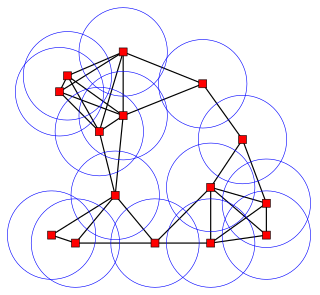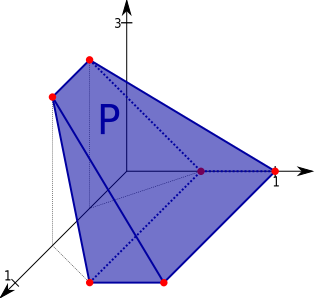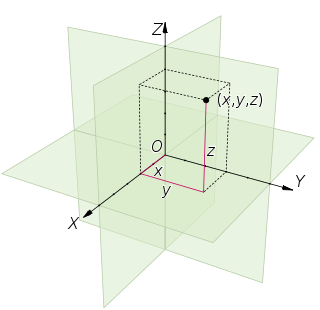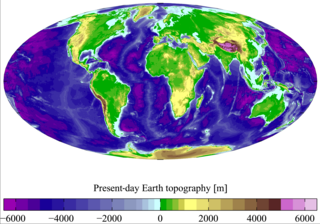
Algebraic geometry is a branch of mathematics, classically studying zeros of multivariate polynomials. Modern algebraic geometry is based on the use of abstract algebraic techniques, mainly from commutative algebra, for solving geometrical problems about these sets of zeros.

In geometry, a polyhedron is a solid in three dimensions with flat polygonal faces, straight edges and sharp corners or vertices. The word polyhedron comes from the Classical Greek πολύεδρον, as poly- + -hedron.
In mathematical analysis, a space-filling curve is a curve whose range contains the entire 2-dimensional unit square. Because Giuseppe Peano (1858–1932) was the first to discover one, space-filling curves in the 2-dimensional plane are sometimes called Peano curves, but that phrase also refers to the Peano curve, the specific example of a space-filling curve found by Peano.

Discrete geometry and combinatorial geometry are branches of geometry that study combinatorial properties and constructive methods of discrete geometric objects. Most questions in discrete geometry involve finite or discrete sets of basic geometric objects, such as points, lines, planes, circles, spheres, polygons, and so forth. The subject focuses on the combinatorial properties of these objects, such as how they intersect one another, or how they may be arranged to cover a larger object.
In mathematics and statistics, a piecewise linear or segmented function is a real-valued function defined on the real numbers or a segment thereof, whose graph is composed of straight-line sections. It is a piecewise-defined function, each of whose pieces is an affine function.

A convex polytope is a special case of a polytope, having the additional property that it is also a convex set of points in the n-dimensional space Rn. Some authors use the terms "convex polytope" and "convex polyhedron" interchangeably, while others prefer to draw a distinction between the notions of a polyhedron and a polytope.
JTS Topology Suite is an open-source Java software library that provides an object model for Euclidean planar linear geometry together with a set of fundamental geometric functions. JTS is primarily intended to be used as a core component of vector-based geomatics software such as geographical information systems. It can also be used as a general-purpose library providing algorithms in computational geometry.

Boolean operations on polygons are a set of Boolean operations operating on one or more sets of polygons in computer graphics. These sets of operations are widely used in computer graphics, CAD, and in EDA.

The Euclidean shortest path problem is a problem in computational geometry: given a set of polyhedral obstacles in a Euclidean space, and two points, find the shortest path between the points that does not intersect any of the obstacles.
Potentially Visible Sets are used to accelerate the rendering of 3D environments. This is a form of occlusion culling, whereby a candidate set of potentially visible polygons are pre-computed, then indexed at run-time in order to quickly obtain an estimate of the visible geometry. The term PVS is sometimes used to refer to any occlusion culling algorithm, although in almost all the literature, it is used to refer specifically to occlusion culling algorithms that pre-compute visible sets and associate these sets with regions in space. In order to make this association, the camera view-space is typically subdivided into regions and a PVS is computed for each region.

A star-shaped polygon is a polygonal region in the plane that is a star domain, that is, a polygon that contains a point from which the entire polygon boundary is visible.

In geometry, a polygon P in the plane is called monotone with respect to a straight line L, if every line orthogonal to L intersects P at most twice.

In geometry, a polygonal chain is a connected series of line segments. More formally, a polygonal chain P is a curve specified by a sequence of points called its vertices. The curve itself consists of the line segments connecting the consecutive vertices.

Two-dimensional space is a geometric setting in which two values are required to determine the position of an element. In mathematics, it is commonly represented by the symbol ℝ2. For a generalization of the concept, see dimension.

The finite element method (FEM), is a numerical method for solving problems of engineering and mathematical physics. Typical problem areas of interest include structural analysis, heat transfer, fluid flow, mass transport, and electromagnetic potential. The analytical solution of these problems generally require the solution to boundary value problems for partial differential equations. The finite element method formulation of the problem results in a system of algebraic equations. The method approximates the unknown function over the domain. To solve the problem, it subdivides a large system into smaller, simpler parts that are called finite elements. The simple equations that model these finite elements are then assembled into a larger system of equations that models the entire problem. FEM then uses variational methods from the calculus of variations to approximate a solution by minimizing an associated error function.

In mathematics, the mountain climbing problem is a problem of finding the conditions that two functions forming profiles of a two-dimensional mountain must satisfy, so that two climbers can start on the bottom on the opposite sides of the mountain and coordinate their movements to meet while always staying at the same height. This problem was named and posed in this form by James V. Whittaker (1966), but its history goes back to Tatsuo Homma (1952), who solved a version of it. The problem has been repeatedly rediscovered and solved independently in different context by a number of people.
In mathematics, the Schoenflies problem or Schoenflies theorem, of geometric topology is a sharpening of the Jordan curve theorem by Arthur Schoenflies. For Jordan curves in the plane it is often referred to as the Jordan–Schoenflies theorem.
In the study of algorithms, an LP-type problem is an optimization problem that shares certain properties with low-dimensional linear programs and that may be solved by similar algorithms. LP-type problems include many important optimization problems that are not themselves linear programs, such as the problem of finding the smallest circle containing a given set of planar points. They may be solved by a combination of randomized algorithms in an amount of time that is linear in the number of elements defining the problem, and subexponential in the dimension of the problem.















